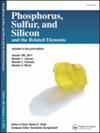磷素现状及提高作物可持续生产磷素利用效率的对策
IF 1.6
4区 化学
Q4 CHEMISTRY, INORGANIC & NUCLEAR
Phosphorus, Sulfur, and Silicon and the Related Elements
Pub Date : 2025-08-14
DOI:10.1080/10426507.2025.2548584
引用次数: 0
摘要
磷(P)是植物生长必需的营养物质,在植物体内的各种生化过程中起着至关重要的作用。然而,土壤中磷的有效性往往是有限的,导致作物产量下降,并与过度施肥相关的潜在环境问题。因此,了解农业土壤中磷的状况并实施有效的策略来提高磷的利用对作物的可持续生产至关重要。了解土壤磷动态及其对作物生产力的影响对于开发旨在提高农业磷利用效率的创新方法和技术至关重要。影响磷有效性的因素包括土壤性质、养分管理方法和环境因素。进一步的管理技术,如高效施磷肥方法、提高磷素吸收的育种、生物肥料和生物接种剂、间作和作物轮作、有机改良剂、堆肥、纳米磷肥、可变施磷肥、生物炭和鸟粪石的使用等,正在导致磷素有效性和利用的更大变化。此外,本文还讨论了过量施用磷的环境影响和缓解措施,包括水土保持措施、土壤磷管理、养分管理规划以及政策和推广战略。这篇综述强调需要一个全面的方法来管理磷,考虑农艺和环境方面,以实现可持续的作物生产。本文章由计算机程序翻译,如有差异,请以英文原文为准。
Phosphorus status and strategies to increase P use efficiency for sustainable crop production
Phosphorus (P) is an essential nutrient for plant growth and plays a crucial role in various biochemical processes within plants. However, the availability of P in soil is often limited, leading to reduced crop yields and potential environmental issues associated with excessive fertilizer application. Thus, understanding the P status in agricultural soils and implementing effective strategies to enhance P utilization is critical for sustainable crop production. The understanding of P dynamics in soil and its implications for crop productivity is essential for developing innovative approaches and technologies aimed at improving P use efficiency in agriculture. Several factors influence P availability for example, soil properties, nutrient management practices and environmental factors. Further management techniques such as efficient P application methods, breeding for improved P uptake, biofertilizers and bio-inoculants, intercropping and crop rotation, organic amendments, composting, nano-phosphatic fertilizers, variable-rate applicators, and the use of biochar and struvite are resulting greater changes in P availability and use. In addition to this, the environmental implications of excessive P application and mitigation measures are discussed, including soil and water conservation practices, soil P management, nutrient management planning, and policy and outreach strategies. This review emphasizes the need for a holistic approach to P management, considering both agronomic and environmental aspects to achieve sustainable crop production.
求助全文
通过发布文献求助,成功后即可免费获取论文全文。
去求助
来源期刊
CiteScore
2.60
自引率
7.70%
发文量
103
审稿时长
2.1 months
期刊介绍:
Phosphorus, Sulfur, and Silicon and the Related Elements is a monthly publication intended to disseminate current trends and novel methods to those working in the broad and interdisciplinary field of heteroatom chemistry.

 求助内容:
求助内容: 应助结果提醒方式:
应助结果提醒方式:


